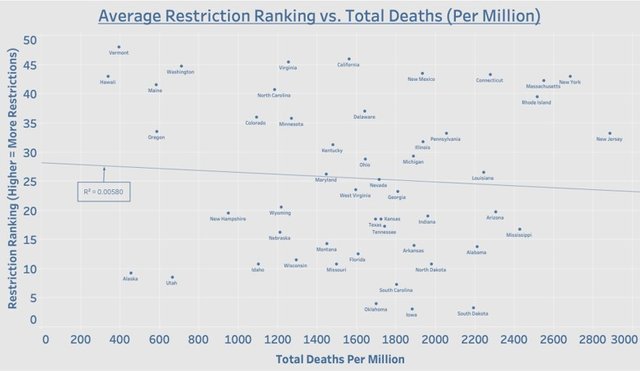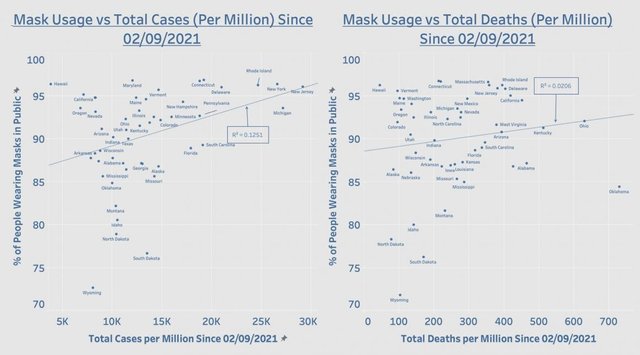
In the preceding article in this series, we reviewed some of the evidence that shows that lockdowns are harmful in themselves, leaving a deadly trail of collateral damage in their wake. But, the argument runs, if we had not imposed these lockdowns, the deaths from Covid-19 would have been several orders of magnitudes greater than any collateral deaths due to the lockdowns. In the long run, then, the lockdowns have actually saved innumerable lives.
But have they? How effective were the lockdowns at containing the spread of the disease and reducing its mortality? That is what we will be looking at in this article.
As we saw in the last article, the independent researcher Ivor Cummins has collated more than twenty papers—not all of them peer-reviewed—on the efficacy of lockdowns as a response to a contagious pandemic. Let’s see what they have so say.
- Vincent Chin, John P A Ioannidis, Martin A Tanner, Sally Cripps, Effects of Non-Pharmaceutical Interventions on COVID-19: A Tale of Three Models, medRxiv, Online (2020)
This paper assessed three SIR models of the Covid-19 pandemic, including two developed by Neil Ferguson of Imperial College. The authors of this paper believe in the germ theory of contagious pathogenic viruses:
Inferences on effects of NPIs are non-robust and highly sensitive to model specification. Claimed benefits of lockdown appear grossly exaggerated. (Chin et al 2)
- Rabail Chaudhrya, George Dranitsarisb, Talha Mubashirc, Justyna Bartoszkoa, Sheila Riazi, A Country Level Analysis Measuring the Impact of Government Actions, Country Preparedness and Socioeconomic Factors on COVID-19 Mortality and Related Health Outcomes, EClinical Medicine, Volume 25, The Lancet, Elsevier (2020)
This study analyzed the effects of various factors on Covid-19 death rates and other health outcomes. The authors found that lockdowns had no impact on mortality, though they did improve recovery rates:
Findings: Increasing COVID-19 caseloads were associated with countries with higher obesity ... median population age ... and longer time to border closures from the first reported case ... Increased mortality per million was significantly associated with higher obesity prevalence ... and per capita gross domestic product ... Reduced income dispersion reduced mortality ... and the number of critical cases ... Rapid border closures, full lockdowns, and wide-spread testing were not associated with COVID-19 mortality per million people. However, full lockdowns ... and reduced country vulnerability to biological threats (i.e. high scores on the global health security scale for risk environment) ... were significantly associated with increased patient recovery rates ... (Chaudhrya et al 1)
However, in our analysis, full lockdowns and wide-spread COVID-19 testing were not associated with reductions in the number of critical cases or overall mortality. (Chaudhrya et al 7)

In New Zealand, Jacinda Ardern’s government introduced very stringent measures to contain the spread of the alleged virus. In late July 2021, the official death toll due to Covid-19 stands at just 26. This is often touted as a good example of the efficacy of lockdowns. But is it?
- John Gibson, Government Mandated Lockdowns Do Not Reduce Covid-19 Deaths: Implications for Evaluating the Stringent New Zealand Response, New Zealand Economic Papers, Taylor & Francis, Online (2020)
The New Zealand policy response to Coronavirus was the most stringent in the world during the Level 4 lockdown. Up to 10 billion dollars of output (≈3.3% of GDP) was lost in moving to Level 4 rather than staying at Level 2, according to Treasury calculations. For lockdown to be optimal requires large health benefits to offset this output loss. Forecast deaths from epidemiological models are not valid counterfactuals, due to poor identification. Instead, I use empirical data, based on variation amongst United States counties, over one-fifth of which just had social distancing rather than lockdown. Political drivers of lockdown provide identification. Lockdowns do not reduce Covid-19 deaths. This pattern is visible on each date that key lockdown decisions were made in New Zealand. The apparent ineffectiveness of lockdowns suggests that New Zealand suffered large economic costs for little benefit in terms of lives saved. (Gibson 1)
Angela Merkel’s Germany has relentlessly pursued the same lockdown policy. But was it really necessary?
- Christof Kuhbandner, Stefan Homburg, Harald Walach, Stefan Hockertz, Was Germany’s Corona Lockdown Necessary?, SAGE Publications, Online (2020)
Official data from Germany’s RKI agency suggest strongly that the spread of the corona virus in Germany receded autonomously, before any interventions become effective. Several reasons for such an autonomous decline have been suggested. One is that differences in host susceptibility and behavior can result in herd immunity at a relatively low prevalence level. Accounting for individual variation in susceptibility or exposure to the coronavirus yields a maximum of 17% to 20% of the population that needs to be infected to reach herd immunity, an estimate that is empirically supported by the cohort of the Diamond Princess cruise ship. Another reason is that seasonality may also play an important role in dissipation. Finally, the ineffectiveness of the NPIs [nonpharmaceutical interventions] is also supported by empirical studies that determine their effects directly: Recent studies have shown that children are less involved in the transmission of SARS-CoV-2 than adults, suggesting that the closure of schools and kindergartens contributes little to curbing the spread of SARS-CoV-2. This finding is supported by studies of previous pandemics: A review of the effects of school closures regarding the spread of SARS-1 in China, Hong Kong, and Singapore in 2003 found only marginal effects. A more recent study that employs German county data, is also fully consistent with our findings. (Kuhbandner et al 7)
Another economist has been led to question the efficacy of lockdowns by looking at several countries and asking whether there was any association between death rates and the stringency of the measures taken to contain the pandemic:
- Christian Bjørnskov, Did Lockdown Work? An Economist’s Cross-Country Comparison, CESifo Economic Studies, (2021)
I explore the association between the severity of lockdown policies in the first half of 2020 and mortality rates. Using two indices from the Blavatnik Centre’s COVID-19 policy measures and comparing weekly mortality rates from 24 European countries in the first halves of 2017–2020, addressing policy endogeneity in two different ways, and taking timing into account, I find no clear association between lockdown policies and mortality development ... Comparing weekly mortality in 24
European countries, the findings in this paper suggest that more severe lockdown policies have not
been associated with lower mortality. In other words, the lockdowns have not worked as intended. (Bjørnskov 1 ... 7)

Figure 1 illustrates the development of weekly mortality (the full lines), relative to the average development in the same weeks in 2017-2019 (the dotted lines). The black line represents the average development in the 12 countries with an average containment and health index in 2020 above the median of all 24 countries while the grey line represents the same development in countries with below-median indices. As such, the figure shows how mortality changed from week to week for the first half of the years. ( Bjørnskov 5)
I leave the reader to study the remaining papers in Ivor’s collection, but the general thrust is clear: lockdowns are ineffective at reducing mortality during a pandemic. This is probably why such measures had never before been deployed to control the spread of a contagious disease, and why they were not being recommended by the WHO or the CDC at the outset of the Covid-19 pandemic.
Lockdown Graphs
As I write these words in July 2021, almost seventeen months of data have been accumulated on the effectiveness of lockdowns. Some governments have imposed very restrictive measures on their people in an attempt to halt the spread of the disease and to reduce its impact on society. Others have taken a much more relaxed approach, leaving it up to individuals to decide for themselves how to respond to this phenomenon. And between these two extremes lie a plethora of intermediate responses—lockdowns of varying degrees of severity or stringency.
If lockdowns were effective at containing the spread and impact of a contagious pathogen, then there would be a clear correlation between the stringency of the lockdown measures and the progress of the disease. States that implemented hard lockdowns would have had favourable outcomes in terms of cases, hospitalizations and deaths. States that took a more lackadaisical approach to the pandemic would have had unfavourable outcomes, with large numbers of cases, hospitalizations and deaths. Do the statistics bear this out?
The stringency of so-called NPIs, or non-pharmaceutical interventions, can be measured in a number of different ways. The commonest method is to calculate a Stringency Index for each country or state. This is a dimensionless figure between 0 (for least restrictive) and 100 (for most restrictive). The Stringency Index is a composite measure based on a collection of response indicators, such as school closures, business closures, travel restrictions, mask mandates, the banning of large-scale events, stay-at-home orders, the quarantining of healthy people, etc.
The most popular of these indices is perhaps the COVID-19 Government Response Tracker, which was developed by the Blavatnik School of Government at the University of Oxford in England:
The Oxford Covid-19 Government Response Tracker (OxCGRT) collects systematic information on policy measures that governments have taken to tackle COVID-19. The different policy responses are tracked since 1 January 2020, cover more than 180 countries and are coded into 23 indicators, such as school closures, travel restrictions, vaccination policy. These policies are recorded on a scale to reflect the extent of government action, and scores are aggregated into a suite of policy indices. The data can help decision-makers and citizens understand governmental responses in a consistent way, aiding efforts to fight the pandemic. Our core working paper (BSG-WP-2020/032) provides more information on methodology and data collection.

Interactive visualizations of these data are available at Our World in Data.
Is there, then, a clear correlation between a country or state’s Stringency Index and their success at containing the spread and impact of Covid-19?
United States of America
The USA makes for an interesting case study. Here we have a single country with a population of over 330 million, but in which each of the fifty states was free to follow its own health policy. This allows us to compare the efficacy of lockdowns of varying stringency in reducing Covid-related deaths. The following graph—from an article on Mises Wire by Anthony Rozmajzl of the Mises Institute—uses Oxford University’s Covid-19 Government Response Tracker, and data from the New York Times’ Covid-19 Data Bot, WalletHub and Hallas et al:

Contrary to what the public health experts have been telling us for more than a year, there is no correlation between the strength of a state’s lockdown measures and total covid-19 deaths. In fact, notorious lockdown states such as New York and New Jersey have some of the worst mortality numbers to date. To blame noncompliance for these poor numbers is ridiculous on its face considering that states with no restrictions, such as Texas and Florida, have far fewer deaths than New York and New Jersey. In fact, you’ll find that every state that has either removed its mask mandate or all covid-19 restrictions entirely is outperforming New York and New Jersey in terms of deaths. (Rozmajzl 6 May 2021)
Rozmajzl found a similar lack of correlation between average lockdown stringency and the number of patients hospitalized with suspected or confirmed covid-19:

The World
This lack of correlation between the stringency of NPIs and the course of the pandemic is replicated in the international data from more than 160 countries across the globe:
Internationally speaking, the data continue to expose lockdowns as the single greatest public health failure in human history. Plotting lockdown stringency against total covid-19 death toll reveals, yet again, zero correlation between the two variables. (Rozmajzl)

In light of a year’s worth of data showing wildly different mortality and hospitalization outcomes for fifty states with fifty very different lockdown stringencies, as well as drastically different mortality outcomes for 166 countries with 166 different lockdown stringencies, one can only marvel that such a deadly and ineffective policy can be recommended by public health experts. (Rozmajzl)
Mask Mandates
One of the most contentious issues in the Covid-19 debate has been the question of the efficacy of masks and other face coverings at reducing the spread of aerosolized contagions. Despite decades of studies showing that the wearing of face masks has no statistical effect on the spread of such diseases, governments, health bodies and media outlets continue to promote them as an essential weapon in the war against SARS CoV-2.
Independent researcher Ian Miller has relentlessly countered this false narrative, compiling a plethora of relevant data on his twitter feed. For example:

The website Rational Ground, which was set up to counter the flood of chaotic COVID-19 misinformation, has collected several of Miller’s charts, proving beyond all doubt the total ineffectiveness of mask mandates. And yet governments around the world continue to impose them.
It wouldn’t be fair to the reader to post quite literally hundreds of charts that show the exact opposite outcomes the media would have one expect after regions remove or institute mask mandates—Ian Miller has done more work in this area than anybody else. It also wouldn’t be fair to claim that mask mandates and mask usage are synonymous. However, based on reactions to states lifting their mask mandates, I don’t think any proponent of mask wearing would seriously expect the same level of mask usage should mandates be lifted. Nevertheless, the claim that mask usage negatively correlates with cases and deaths is easily refuted with a quick look at the data. Given the data available, we’ll again only be looking at the fifty states. (Rozmajzl)

In the early stages of the pandemic, Canadian physicist and researcher Denis Rancourt compiled a review of the scientific literature on the efficacy of masks (and respirators) at preventing respiratory diseases, such as influenza and Covid-19:
There have been extensive randomized controlled trial (RCT) studies, and meta-analysis reviews of RCT studies, which all show that masks and respirators do not work to prevent respiratory influenza-like illnesses, or respiratory illnesses believed to be transmitted by droplets and aerosol particles. (Rancourt 1)
In his subsequent analysis, Rancourt attempts to account for this ineffectiveness in the light of the conventional science, which claims that these respiratory illnesses are caused by pathogenic viruses transmitted from person to person via exhaled droplets and aerosols:
Furthermore, the relevant known physics and biology, which I review, are such that masks and respirators should not work. It would be a paradox if masks and respirators worked, given what we know about viral respiratory diseases: The main transmission path is long-residence-time aerosol particles (< 2.5 μm), which are too fine to be blocked, and the minimum-infective-dose is smaller than one aerosol particle. (Rancourt 1)

In conclusion, not only were the lockdowns deadly in their own right, they were also wholly ineffective at containing the spread of Covid-19 or reducing the impact of the pandemic.
And that’s a good place to stop.
References
- Christian Bjørnskov, Did Lockdown Work? An Economist’s Cross-Country Comparison, CESifo Economic Studies, (2021)
- Rabail Chaudhrya, George Dranitsarisb, Talha Mubashirc, Justyna Bartoszkoa, Sheila Riazi, A Country Level Analysis Measuring the Impact of Government Actions, Country Preparedness and Socioeconomic Factors on COVID-19 Mortality and Related Health Outcomes, EClinical Medicine, Volume 25, The Lancet, Elsevier (2020)
- Vincent Chin, John P A Ioannidis, Martin A Tanner, Sally Cripps, Effects of Non-Pharmaceutical Interventions on COVID-19: A Tale of Three Models, medRxiv, Online (2020)
- John Gibson, Government Mandated Lockdowns Do Not Reduce Covid-19 Deaths: Implications for Evaluating the Stringent New Zealand Response, New Zealand Economic Papers, Taylor & Francis, Online (2020)
- Thomas Hale et al, Variation in Government Responses to Covid-19, BSG-WP-2020/032, Version 12.0, Blavatnik School of Government, Oxford University, Oxford (2021)
- Christof Kuhbandner, Stefan Homburg, Harald Walach, Stefan Hockertz, Was Germany’s Corona Lockdown Necessary?, SAGE Publications, Online (2020)
- Denis G Rancourt, Masks Don’t Work: A Review of Science Relevant to COVID-19 Social Policy, Research Gate (2020)
- Anthony Rozmajzl, Why Is There No Correlation between Masks, Lockdowns, and Covid Suppression?, Mises Wire, 4 May 2021, Mises Institute, Online (2021)
Image Credits
- COVID-19 Poster: © 2021 Dublin Region Homeless Executive, Fair Use
- Jacinda Ardern, Prime Minister of New Zealand: © 2021 Sky UK, Fair Use
- Figure 1 (Bjørnskov 12: © 2021 Oxford University Press, Fair Use
- Covid-19 Stringency Index (19 July 2021): © Thomas Hale et al, Creative Commons License
- Effectiveness of Lockdowns in the US (Deaths per Million): © Anthony Rozmajzl, Fair Use
- Effectiveness of Lockdowns in the US (Hospitalizations per Million): © Anthony Rozmajzl, Fair Use
- Effectiveness of Lockdowns across the World (Deaths per Million): © Anthony Rozmajzl, Fair Use
- Mask Mandates in France: © World Health Organization, Creative Commons License
- Mask Usage in the US (Cases and Deaths per Million): © Anthony Rozmajzl, Fair Use
- Ireland’s Record-Breaking Lockdown: © Thomas Hale et al, Oxford COVID-19 Government Response Tracker, Creative Commons License
Online Resources
- The Fat Emperor
- Collateral Global
- RIP.ie
- Central Statistics Office (CSO)
- Northern Ireland Statistics and Research Agency (NISRA)
- Covid-19 Pandemic
- Covid-19 Pandemic in the Republic of Ireland
- Covid-19 Pandemic in Northern Ireland
- Irish Government Updates on Covid-19
- Northern Ireland Covid-19 Statistics
- The CIA’s World Factbook
- EUROMOMO
- Our World in Data
- Rational Ground
